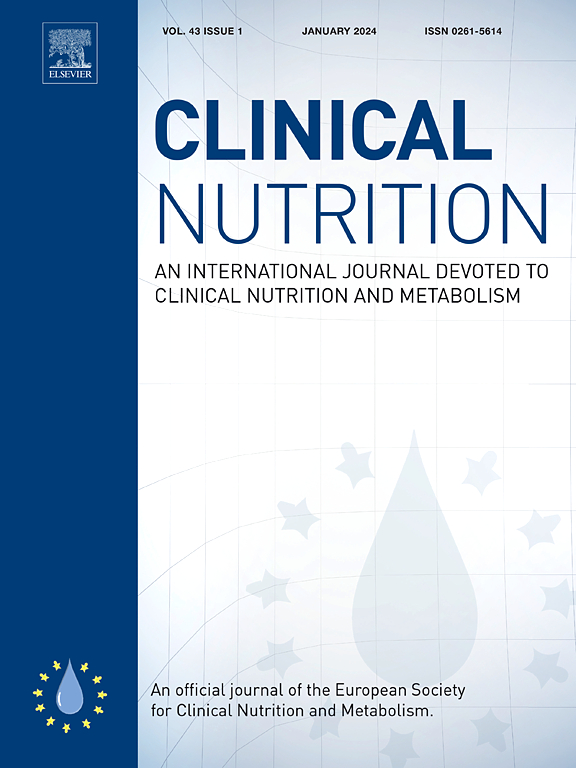Water intake in athletes: Agreement between food records and isotope-dilution methods
IF 6.6
2区 医学
Q1 NUTRITION & DIETETICS
引用次数: 0
Abstract
Background
Although water intake (WI) is commonly estimated through self-reporting, its inaccuracy is reported. Water turnover (rH2O)-derived WI is the reference method; however, it is costly. The study aimed to validate alternative methods for determining WI in a group of athletes.
Methods
Eighty-two athletes (20.4 ± 5.1 years; 28 females) were included in this cross-sectional validation study. Doubly labelled water (DLW) determined rH2O and rH2O-derived WI by subtracting metabolic, transcutaneous, and inspired water from rH2O (reference). The rH2O components were determined by alternative approaches: i) average values of macronutrients instead of individual food records (DLW-derived WI); ii) estimating total energy expenditure (TEE) and rCO2 through a predictive equation instead of DLW (2H-derived WI); iii) estimating rH2O by prediction equation (equation-derived WI). Food records were employed to determine WI (food record-derived WI).
Results
Only DLW-derived WI showed no significant differences compared to reference in both sexes (females: 2 mL/day, p = 0.183; males: −4 mL/day, p = 0.118). 2H-derived WI showed significant but small differences (females: 23 mL/day, p = 0.001; males: 32 mL/day, p < 0.001) while food record-derived WI showed the largest differences (females: −924 mL/day, p < 0.001; males: −1504 mL/day, p < 0.001). DLW-derived and 2H-derived WI showed good performance [r2 > 0.987 and concordance correlation coefficient (CCC) > 0.993], while food record-derived WI showed poor performance [r2 < 0.031 and CCC < 0.133)].
Conclusion
Although some alternative approaches provide adequate estimates, DLW- and 2H-derived WI are the only valid methods to determine WI in our sample of competitive athletes. These approaches are less costly and could contribute to the development of WI guidelines for athletes. Food records underestimate WI, but evidence-based recommendations could reduce misrecordings.
运动员的水分摄入量:食物记录与同位素稀释法之间的一致性。
背景:尽管水摄入量(WI)通常是通过自我报告来估算的,但有报告称其不准确。水周转率(rH2O)得出的水摄入量是一种参考方法,但成本较高。本研究旨在验证在一组运动员中测定水分摄入量的其他方法:方法:82 名运动员(20.4 ± 5.1 岁;28 名女性)参加了这项横断面验证研究。双标记水(DLW)通过从 rH2O(参考值)中减去代谢水、经皮水和吸入水来测定 rH2O 和 rH2O 衍生 WI。rH2O 成分是通过其他方法确定的:i) 用主要营养素的平均值代替单个食物记录(DLW 衍生 WI);ii) 通过预测方程代替 DLW 估算总能量消耗(TEE)和 rCO2(2H 衍生 WI);iii) 通过预测方程估算 rH2O(方程衍生 WI)。采用食物记录确定 WI(食物记录衍生 WI):结果:与参考值相比,两性只有 DLW 衍生的 WI 没有显著差异(女性:2 毫升/天,p = 0.183;男性:-4 毫升/天,p = 0.118)。2H 导出的 WI 显示出显著但较小的差异(女性:23 毫升/天,p = 0.001;男性:32 毫升/天,p 2H 导出的 WI 显示出良好的性能[r2 > 0.987 和一致性相关系数 (CCC) > 0.993],而食物记录导出的 WI 显示出较差的性能[r2 结论]:尽管一些替代方法能提供适当的估计值,但在我们的竞技运动员样本中,DLW 和 2H 导出的 WI 是确定 WI 的唯一有效方法。这些方法成本较低,有助于制定运动员的 WI 指南。食物记录低估了 WI,但基于证据的建议可减少错误记录。
本文章由计算机程序翻译,如有差异,请以英文原文为准。
求助全文
约1分钟内获得全文
求助全文
来源期刊

Clinical nutrition
医学-营养学
CiteScore
14.10
自引率
6.30%
发文量
356
审稿时长
28 days
期刊介绍:
Clinical Nutrition, the official journal of ESPEN, The European Society for Clinical Nutrition and Metabolism, is an international journal providing essential scientific information on nutritional and metabolic care and the relationship between nutrition and disease both in the setting of basic science and clinical practice. Published bi-monthly, each issue combines original articles and reviews providing an invaluable reference for any specialist concerned with these fields.
 求助内容:
求助内容: 应助结果提醒方式:
应助结果提醒方式:


